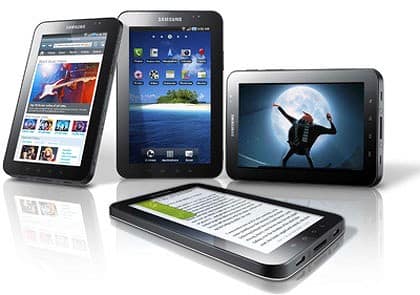
The apparent pricepoints for Samsung’s forthcoming Galaxy Tab tablet are enough to make one’s eyes water – initially £799, ($1255.63) now sub-£599 ($941.33) in the UK.
That makes the device a tough sell against the larger, sexier and mostly cheaper iPad, and suggests Samsung hopes it will be subsidised through mobile networks. U.S. networks have now confirmed this.
But allying with mobile may not be the natural route to market for tablets. These things are mostly leisure computers, built for sofa browsing; at least, that’s how many of us early adopters have experienced iPad.
Samsung seems to be marketing the Tab as a mobility device, something to be pulled out one’s pocket with which to get directions and find recipes whilst on the go…
But this begs the question – so what’s a mobile phone for then? Today’s smartphones, not least the ones running the same Android OS that also powers the Tab, already perform the same functions, in a form factor that’s far more suited for the pocket. In particular, Samsung’s own Galaxy S phone, with its large, vivid display, is already camped firmly on this space sought by its bigger brother.
Many international markets are well used to network-subsidised phone devices – it’s a pattern familiar enough that many out-of-contract customers hop network precisely to get a new handset…
Networks also subsidise netbook computers. But the world’s biggest phone maker, Nokia (NYSE: NOK), was unable to crack this model, with its Notebook netbook.
Consumers are unlikely to take out two SIM contracts (one for phone, another for tablet). And the number of people who will be prepared to forgo the opportunity for a new phone by taking only a tablet SIM contract, at this time when there are so many new smartphones out there, is likely to be small.
Prior to Apple’s release, many observers expected that iPad would sell as subsidised, iPhone-style, by mobile carriers. Yet, in their first full quarter, they sold 3.27 million all by themselves. AT&T (NYSE: T) has only half a million iPad users. That’s good going on direct sales, for what is still a relatively high price device.
But iPad’s a premium product. Android-powered tablets should be far cheaper, and have the potential to lead the market, in the way we are now seeing the OS’ activations surpass iPhone’s in the palm.
At this pricepoint, the Galaxy Tab is not a real competitor to iPad – it’s much smaller, less conducive to reading at length, and the likely reality that tablets are domestic, rather than out-of-house, mobiles will suppress the incentives to buy a SIM-subsidised Tab. Better to drive down those tech costs and introduce a more appealing direct-retail price.